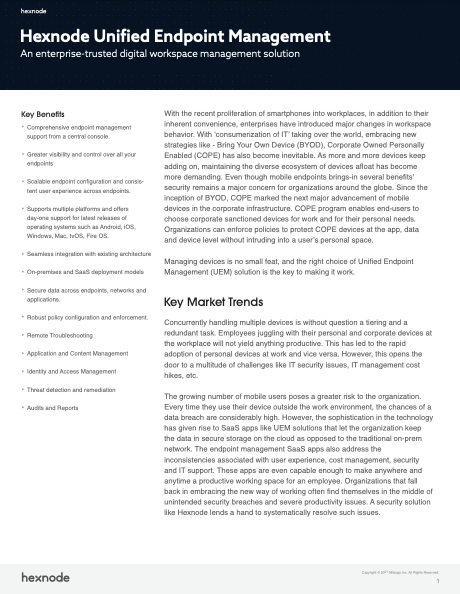Device health is a very important factor when it comes to running a business smoothly. Almost everyone has experienced a delayed delivery on an online purchase. This might be because of device functionality issues.
Consider a hypothetical situation, where you are running an online shopping store. You have a few warehouse staff who are in charge of shipping. What if one of their work devices gets damaged? The shipments they are responsible for will be delayed.
Whether it is a small business or a large one, monitoring work device health is critical if you want the business to run smoothly.
- Real-time device health monitoring
- Featured resource
- Hexnode Unified Endpoint Management
- How can a UEM like Hexnode help with device health monitoring and alerting
- Device health monitoring
- 1. Dashboard
- 2. Device information
- 3. Application information
- 4. Kiosk mode indicator
- 5. Data management
- 6. Action history
- 7. Recent location and remote view
- Device health alerting
- 1. Setting up notifications
- 2. Scheduled reports
- 3. Geofencing
- In conclusion,
- Sign up for a free trial
Real-time device health monitoring
Real-time monitoring means that the device is constantly monitored even when it is functioning. In this way, if any issues are detected with the device, it can be corrected immediately and the device can resume function properly.
There is an old saying, “Prevention is better than cure”, and real-time device health monitoring does just that. Identifying and managing problems way before it gets out of hand is better than waiting for the problem to come and then solving it.
When it comes to device health, it is always better to solve issues in the early stages. This not only saves money but also minimizes productivity loss due to hardware problems.
Get started with Hexnode’s Unified Endpoint Management solution to manage all your endpoints from a central console.

Featured resource
Hexnode Unified Endpoint Management
How can a UEM like Hexnode help with device health monitoring and alerting
When you think of UEMs the first thing that comes to mind is device management. Modern UEMs like Hexnode offer much more than just endpoint management. Device health monitoring and alerting is one of the extra features you get with Hexnode.’
Device health monitoring
There are multiple features available in Hexnode that aid in device health monitoring.
1. Dashboard
Dashboard or the homepage of Hexnode management console gives an overview of all the devices managed by your organization. General information like the number of devices enrolled in the organization, number of devices without a password, number of devices that are not compliant with organizational policies are all available from the dashboard.
The dashboard also gives detailed information like devices locked in kiosk mode, device check-ins, device ownership type (corporate-owned or personal), location history of devices, and actions taken on the device by the administrator.
2. Device information
Apart from the general overview of all devices, each device can be monitored individually. Data regarding the device’s health such as battery level, storage level, and compliance details are given here.
Monitoring a device’s battery health is a very basic yet important thing. By monitoring the device battery levels, the downtime due to device inactivity can be reduced.
3. Application information
Hexnode provides IT admins with a list of all applications and software installed on a device. Using this list, admins can easily find out all the unwanted applications that are installed in a device and find out if there are any fishy ones.
4. Kiosk mode indicator
Many businesses use devices as kiosk devices. This means that devices will be restricted to a single application or a group of applications specified by the organization. Kiosk mode can be used in many ways, for advertising purposes, to increase productivity, and so on.
Constant monitoring is required for devices in kiosk mode. If the device exits kiosk mode by any means, then its purpose is not satisfied. Hexnode provides a kiosk status indicator to notify admins whether the device is in kiosk mode or not.
5. Data management
Hexnode gives you a detailed idea about data usage by a device. From total data used to each type of data (mobile data, Wi-Fi, or any other tethered data), IT admins can monitor the data usage of any device for a select amount of time. App-specific data usage details are also available.
Data restriction is a feature provided by Hexnode that lets IT admins limit the data usage in end-user devices.
6. Action history
All IT admins take several steps to control an employee device following organizational rules. An IT admin can easily lose track of all the actions performed on the device.
Hexnode provides action history to give IT admins a clear picture of what all settings are configured on a device, using the UEM console. The Action History section of the UEM interface provides a complete report on all of the settings applied by the IT administrator.
Action history not only provides a list of all actions made by the admin but also shows the status of the action – whether or not the action was successfully applied on the device.
7. Recent location and remote view
It is very important to make sure that all the devices deployed by a company are present in the area/region it was meant to function in. Device location can also help locate lost/stolen devices. Recent location fetches the exact location of any location-enabled devices managed by the organization.
Remote view is a functionality offered by Hexnode, where admins can remotely view the screen activity of employee devices. Using the remote view function, all the activities of end users can be monitored by the admin. Remote view can also help in troubleshooting issues.
Device health alerting
When there is a problem associated with device health, the IT admin must be informed. Not all problems are noticed by the end-user, so, it is best to automate this task. In this way, whenever a problem or undesired change occurs in a device the IT admin is notified.
Device health alerting is like a pre-emptive measure used by companies to stay ahead of device health issues. Some preemptive measures offered by Hexnode are:
1. Setting up notifications
Notifications can be used to automatically alert IT admins as well as concerned end-users whenever an event takes place on the device. For example, when the battery level falls below a specified value a notification can be sent to the admin.
Admins can specify the events where they must be notified. Events like an exit from kiosk mode, enabling of a mock location, device failing to meet compliance standards, etc. can all generate notifications. Notifications are sent to the individual concerned through email.
2. Scheduled reports
Scheduled reports are a way of notifying admins about device health at regular intervals of time. Reports give admins a detailed overview of users, applications, data management, and compliance details of all or select devices managed by the organization.
Scheduled reports are automatically created and sent to the admins at regular time intervals. The time interval can be specified by the admin. Reports can also be created manually and downloaded at any point in time.
3. Geofencing
Geofencing is a location-based restriction that allows IT admins to create a virtual boundary around a specific location. This boundary can be used to dynamically manage devices based on whether the device is inside or outside the boundary.
This feature can be used in a variety of scenarios, such as making company resources available based on device location or implementing a location-based compliance setting.
In conclusion,
If used effectively, all of these capabilities can give an IT administrator the ability to stay ahead of device health issues. Too much data can be confusing, and it might even have a negative impact on health monitoring. So, while monitoring device health, remember not to go overboard and collect every piece of device information. Use only those that are absolutely necessary.
Sign up for a free trial
Sign up for a 14-day free trial with Hexnode and explore the Remote monitoring and management capabilities of Hexnode.
Sign up




